Interiorscape Basics
Chapter Two: Pests 101
A pest is an organism (e.g., insect, plant, bacterium, virus, fungus, animal) that competes with human interests. The status of a pest species depends on a number of factors, including the habitat in which it’s found, its population size and the attitude of the person it impacts. Outdoors, many insects would be considered highly beneficial through their activities as pollinators, decomposers, predators and parasites. For example, a ladybird beetle that feeds on plant-feeding insects (aphids) is beneficial to humans if the plant it saves is of value to us. If another beetle feeds on the roots of the plant, it may cause damage to the aesthetic or economic return on that plant. This beetle would be called a pest and require human management of its population. In interiorscapes, we usually think of pests as either a type of insect or a plant disease.
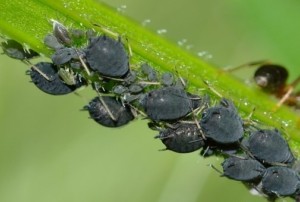
How many plant pests can you identify?
The goal should be to suppress a pest population to an acceptable level in interiorscapes. The amount of effort it takes to achieve pest control depends on the level of infestation. This means that the client sees an aesthetically pleasing plant. Your aim is to keep pest damage below the level where the pest causes damage to the plant that reduces its value. Frequently, this is when we are asked by the client to replace the plant. The point where you should begin control is when you have noticed a population, but damage to the plant is not visible yet to the client.
Pest control in interiorscapes has become a highly sensitive issue. Twenty years ago it was possible to walk into an account in full spray gear (coveralls, facemask, respirator, boots and gloves) and people would be thrilled to see you because they didn’t want ANY bugs in their office space. Today, whenever you mist a plant with just soap and water, you may get asked, “What are you spraying?” People are justifiably nervous about what toxins may be added to their environment.
In pest control today, it is best to view control as a strategy or combination of strategies that allow management of a pest population to a level where the economic or detrimental effects are acceptable. This acceptable level varies for different pests and circumstances. Today, eradication or total elimination of a pest is rarely thought of as the final goal unless a pest damages high value plantings or serves as a vector (carrier) of disease organisms.
Insects and Mites
Cyclamen mites, spider mites, mealybugs, thrips and scale are the most common insects indoors. No matter how careful you are, many plants under stress from their indoor environment become susceptible to and will come down with a case of the critters. Even under the grower’s watchful eye, insects and mites happen. Let’s take a look at each and discuss the plants most attractive to that pest and ways to control an outbreak in an account.
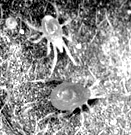
Spider mites
Cyclamen mites
What is causing that suspicious looking new growth that you’ve been noticing on so many of your Dracaenas? Could it simply be low light or too much water? It’s almost as if something’s been sucking the “green” out of the plant. The new growth is deformed and crooked. What is it? Well, chances are it is cyclamen mites. Lately, cyclamen mites can be found on many plants, especially Dracaenas. Mites’ food source is plant sap, which they suck by piercing the undersides of leaves. Their feeding collapses cells, produces yellow speckling on upper leaf surfaces, browns leaves and can eventually kill entire plants if left unchecked.

Cyclamen is prone to cyclamen mites
Cyclamen mite (Steneotarsonemus pallidus) was first recorded in 1898 as a greenhouse pest to cyclamen and African violets, and as a garden pest to snapdragons, dahlias and strawberries. For almost one hundred years, those plants (and a few other garden varieties) were the only plants on which you were likely to see cyclamen mite damage. Today, this tiny reddish-brown mite can be found on many interiorscape plants including: Aeschynanthus, Aphelandra, Begonia, Crassula, Dizygotheca, Dracaena, Hedera, Polyscias and Schefflera arboricola, to name a few.
The adult mite is too small to see with the naked eye, about one half the size of a spider mite, or 1/100th of an inch in length. Even without being able to see them, you can identify them by the characteristic reaction of the plants they feed on. Due to their tiny size and prolific reproductive capabilities, infestations often get beyond our control before we even notice symptoms on plants. New growth is always affected by being stunted and twisted. Learning how to identify cyclamen mites and how to monitor their presence, as well as employ timely control tactics can reduce the negative effects.
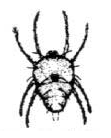
Spider mite
Cyclamen mites do not produce webbing, so keep a close eye out for telltale distorted, stunted new growth as an early clue of an infestation. They can nest at the soil level but also in the buds and on the new growth. The cyclamen mite tends to be on top of the leaf, feeding by sucking the leaf’s juices. One female can produce over one hundred eggs in her short three weeks of adult life. These eggs hatch in one week and a mere ten days later reach adulthood.
Look and look again for signs of cyclamen mite damage on the new growth. Sometimes, the new growth distortion can look like damage from incorrect watering. On some types of plants the foliage may turn purplish or reddish brown at the base of the leaf. This is characteristic of an Aeschynanthus with the mite. The new growth of Schefflera arboricola will become just a hard woody stub at the top of the branch. The new growth of Aglaonema will look like “pinheads” sticking straight up but never opening. As the population grows, many plants will shed leaves from near the soil outward. With D. marginatas, leaf loss is usually the middle foliage on a cane.
Spider Mites
Spider mites are not insects but are more closely related to spiders. These arachnids have four pairs of legs, no antennae and a single, oval body region. Most spider mites are very tiny and have the ability to produce fine silk webbing for moving about on plants and for protection. Spider mites produce a sticky silk webbing that collects dust and results in dirty looking foliage.
Spider mites begin life as eggs, hatch into six-legged larvae, quickly become eight legged nymphs and finally turn into reproductive adults, yielding more eggs and restarting the life cycle. As they change life stages, their “skins” are shed, leaving a grayish residue. They flourish in low humidity environments at room temperature and above. Their rate of reproduction increases as temperatures increase and humidity remains low. One female can produce eight million babies in one month at 80 degrees Fahrenheit.
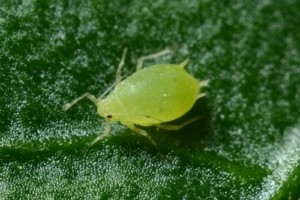
A closer look at a spider mite
You may first notice tiny yellow or white speckles or dirty looking foliage. The spots occur when the spider mites with their tiny mouthpart pierce the foliage and remove the cellular content. If the spider mites concentrate their feeding to one area of the foliage it will appear bronze and eventually fall off. Their food source is plant sap, which they suck by piercing the undersides of leaves. Their feeding collapses cells, produces yellow speckling on upper leaf surfaces, browns leaves and can eventually kill entire plants, if left unchecked.
The preferred indoor plant species for spider mites to infest include Aspidistra, Codiatum, D. marginata, Ficus, Hedera, Schefflera, and palms.
How to Prevent Spider Mite Damage:
- Anticipate their presence, especially on preferred hosts in dry locations.
- Watch for signs of webbing.
- Check plants often by running your hand over the bottom surface of a leaf. If it feels gritty, it has mites.
- Clean foliage often and thoroughly by wiping with baby wipes or wet paper towels.
- Maintain proper moisture in growing media at all times.
- Keep plants clean by periodically washing with soap and water.
- Avoid improper light levels per plant types.
- Early detection and immediate treatments are essential.
- Remove severely damaged parts and treat remainder.
- Repeating the treatment is a must. Spray and wipe at least three weeks in a row.
- Spray foliage thoroughly, especially leaf undersides with approved products.
Controlling Mites
As with all pests on interiorscape plants, your best control is to keep plants as healthy as possible. With proper care, a plant is better able to fight off a pest. At the first sign of an infestation start spraying with your ever-at-the-ready spray bottle of soap and water mixture and be sure and get the tops of the leaves. Neem Oil® will work on mites. Hand wiping with baby wipes also works to control an outbreak. Try using Pro-tekt® in your weekly watering as a preventative to mites. If you continue to see signs after spraying/wiping at least three times weekly, you might try using a pyrethrin-based spray. Be sure and read the label and follow directions carefully to get pesky mites under control.
Mealybug
White cottony blobs that look like little tufts of cotton indicate a mealybug infestation. Aglaonema are a favorite for mealybugs, but pothos, crotons, grape ivy, bird of paradise and just about any plant next to a plant with mealybug can become infested.
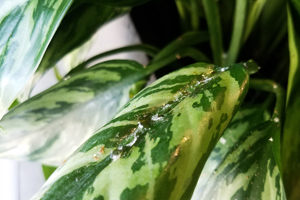
Create a dilution of rubbing alcohol to treat leaves
Mealybugs are usually found on the undersides of leaves and at the point where a leaf attaches to the stem. The insects get inside the sheath so are protected from sprays. Mealybug has a wax filament that repels pesticides and makes the insects a bit difficult to control. Start by squishing as many as you can using a baby wipe with rubbing alcohol added. Remove any badly infested moss. Spray the rest of the moss with the rubbing alcohol and water mixture mentioned above.
Heavier infestations may call for the plants to be sprayed, as well. For this, use your soap and water mix and add a teaspoon of rubbing alcohol, not too much or you can burn the leaves. Also try Brand X. Finish up by adding some systemic insecticide approved for the interiorscape to the soil to boost your control program.
Thrips
This pest is very small and easy to miss until you learn to recognize the damage. Mature thrips are smaller than aphids and slightly bigger than a mite. Adults are long and narrow, with black and white stripes running across their back. You are most likely to find thrips on Schefflera, Ficus, Philodendron and the occasional palm. Thrips rasp and scrape the surface of the plant and suck up the sap that is released. Watch for whitish, silvery speckles on the leaf. As the population grows, the larger silvery patches can overtake whole leaves.
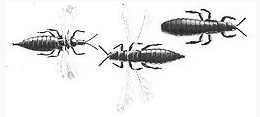
Pesky thrips damage plant leaves
Begin control by removing the worst damaged leaves. Then, wipe down the remaining leaf surfaces with baby wipes or wet paper towels with a bit of soap. Spray regularly with your soap and water mix. Next, place blue sticky cards near the soil. For ongoing prevention, increase humidity and water, as thrips prefer excessively dry conditions of the air and soil.
Scale
There are two major families of scale insect that attack interior plants: soft scales (Family Coccidae) and armored scales (Family Diaspididae). Soft scale (these include brown soft scale, hemispherical scale and black scale) are usually brown or black, produce honeydew and are one-eighth to one-fourth inch at their full adult size. Scale can be found on the stems, branches and leaves of susceptible plants, such as Ficus, Spathiphyllum, Aspidistra, citrus and cactus. Soft scale produce abundant amounts of honeydew, which is the sticky drips that you feel and see. Honeydew is actually excrement from the scale feeding on the plant.
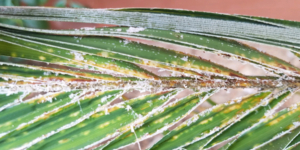
Scale infestations can be tricky to remove and treat
Armored scales are often white, circular and hard, do not produce honeydew and are about one-eighth inch in size, generally smaller than soft scales. Armored scales are circular or oval hard bumps with no visible head or legs. Susceptible plants are Ficus, Spathiphyllum, Rhapis, Aspidistra and cactus. On Rhapis it shows up as tiny white dots on the emerging new growth, especially from soil level. It scars the new growth with translucent dots. On Aspidistra it shows up near soil level along the stems of the leaves. Look closely, wiping it off with baby wipes.
Control of all types of scale can be difficult because they protect themselves from temperature extremes by developing protective external shells. These shells are made from excreted layers of wax mixed with cast-off skin shed during their developmental stages. Scales have piercing and sucking mouthparts and are closely related to mealybugs. If numerous, their feeding will weaken the plant, causing distortions in the leaves, loss of plant vigor and injury from their toxic saliva. Start with pruning off the worst infestations and then squish any others by using baby wipes. To make your baby wipes even more effective add some rubbing alcohol to your wipes container and shake. Follow up with cleaning the honeydew off by spraying the plant thoroughly with Brand X®. ACECAP®, a systemic insecticide implant, works well for large Ficus and large palms.
Pest Patrol
One key to understanding how to control all pests on interiorscape plants is to be aware of how to decrease plant stresses resulting from the indoor environment. Plants under stress are generally more susceptible to infestations of insects and mites. In addition, the same pest population size can cause more visible plant damage on a stressed plant because of its weakened condition. By keeping plants healthy with proper care, the plant will be better able to fight off a pest.
A Simple Mixture
To make a simple interior safe pest spray, mix one teaspoon of Castile soap with a quart of water in a spray bottle and shake. Spray the whole plant to the point of dripping for effective control.
